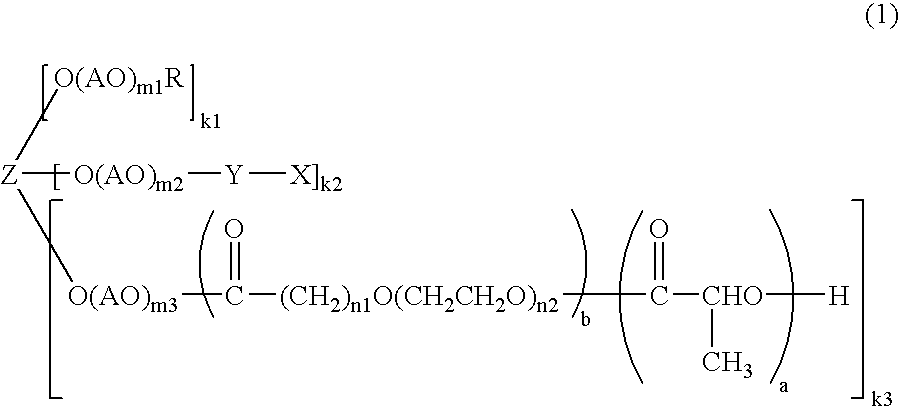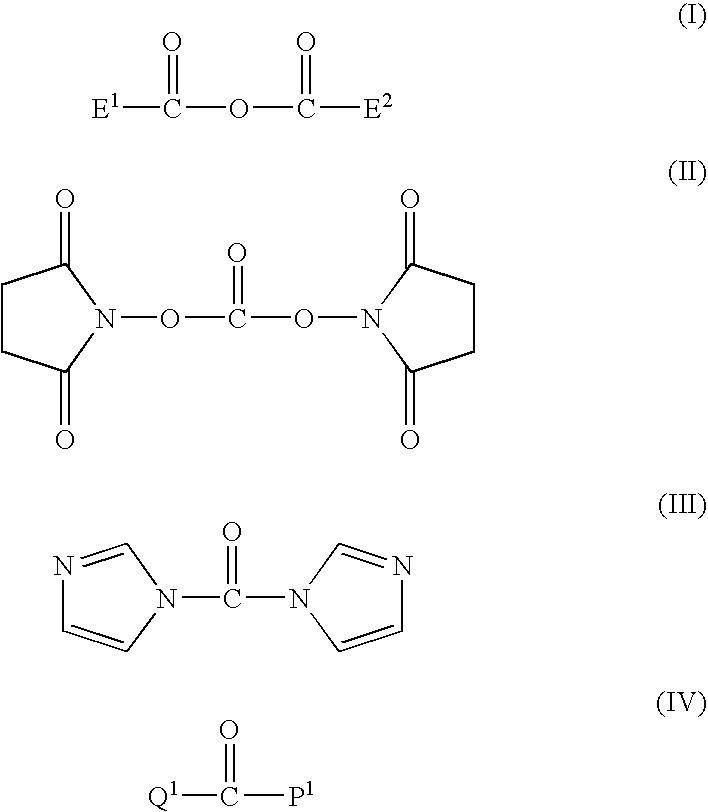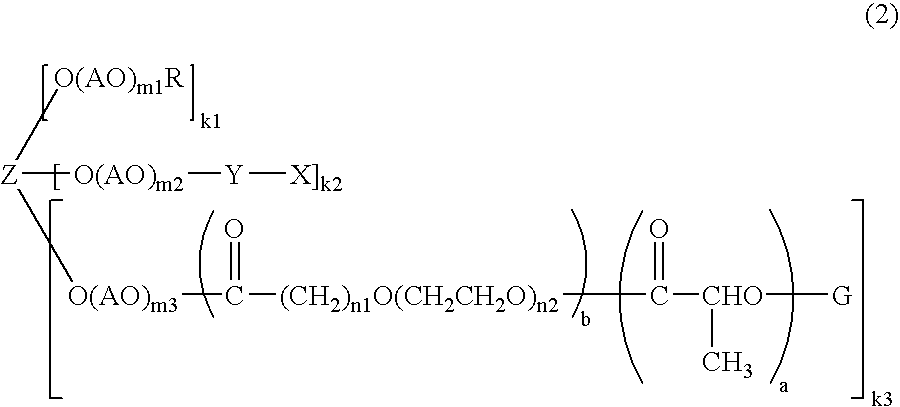Method for producing biodegradable polyoxyalkylene derivative
- Summary
- Abstract
- Description
- Claims
- Application Information
AI Technical Summary
Benefits of technology
Problems solved by technology
Method used
Image
Examples
production example 1
[0085]Into a 3-1 four-necked flask, methoxypolyethylene glycol (450 g, 0.0225 mol. SUNBRIGHT MEH-20T (manufactured by NOF CORPORATION: molecular weight 20000)) and toluene (1200 g) were introduced and stirred therein. After heating to 110° C., the mixture was dehydrated (50 g of toluene was distilled off). After cooling to 90° C., tin 2-ethylhexanoate (0.81 g) dissolved in dry toluene (9 g) and 3,6-dimethyl-1,4-dioxane-2,5-dione (9.73 g, 0.0675 mol) were successively added thereto. Then, the mixture was heated to 110° C. and reacted for 6 hours.
[0086]After the completion of the reaction, the reaction mixture was cooled to 40° C. and ethyl acetate (1070 ml) and hexane (1500 ml) were added to thereby precipitate crystals. After filtering the crystals, hexane (1500 ml) was added followed by stirring. The crystals were filtered and dried under reduced pressure to give methoxypolyethylene glycol-polylactide (trimer) (448 g).
[0087]1H-NMR (CDCl3, 400 MHz)
[0088]δ 1.45-1.61 (m, —CH(CH3)O—), ...
production example 2
[0089]Into a 3-1 four-necked flask, pentaerythritol polyethylene glycol (300 g, 0.03 mol; SUNBRIGHT PTE-10000 (manufactured by NOF CORPORATION: molecular weight 10000)) and toluene (900 g) were introduced and stirred therein. After heating to 110° C. the mixture was dehydrated (100 g of toluene was distilled off). After cooling to 90° C., tin 2-ethylhexanoate (4.32 g) dissolved in dry toluene (20 g) and 3,6-dimethyl-1,4-dioxane-2,5-dione (58438 g, 0.405 mol) were successively added thereto. Then, the mixture was heated to 110° C. and reacted for 10 hours.
[0090]After the completion of the reaction, the reaction mixture was cooled to 40° C. and ethyl acetate (900 ml ) and hexane (2700 ml) were added to thereby precipitate crystals. After filtering the crystals, hexane (2700 ml) was added followed by stirring. The crystals were filtered and dried under reduced pressure to give pentaerythratol polyethylene glycol-polylactide (tetramer) (305.7 g).
[0091]1H-NMR (CDCl3, 400 MHz)
[0092]δ 1.45...
example 1
[0093]Into a 500-ml four-necked flask, methoxypolyethylene glycol-polylactide (30 g, 0.0015 mol) obtained in Production Example 1 and toluene (200 g) were introduced and stirred therein. After heating to 110° C., the mixture was dehydrated (37 g of toluene was distilled off). After cooling to 60° C., glutaric anhydride (1.53 g, 0.0134 mol) and potassium carbonate (3.1 g, 0.0225 mol) were added thereto. Then, the mixture was reacted at 60° C. for 27 hours.
[0094]After the completion of the reaction, the insoluble matters were filtered. After cooling to 40° C., ethyl acetate (100 ml) and hexane (350 ml) were added to thereby precipitate crystals. After filtering the crystals, 2-propanol (700 ml) was added and recrystallization was performed. After filtering the crystals, recrystallization was further repeated once. Next, the crystals were filtered, washed with hexane (700 ml) and filtered. The crystals were dried under reduced pressure to give methoxypolyethylene glycol-polylactide (tr...
PUM
| Property | Measurement | Unit |
|---|---|---|
| Magnetic field | aaaaa | aaaaa |
| Time | aaaaa | aaaaa |
| Time | aaaaa | aaaaa |
Abstract
Description
Claims
Application Information
 Login to View More
Login to View More - R&D
- Intellectual Property
- Life Sciences
- Materials
- Tech Scout
- Unparalleled Data Quality
- Higher Quality Content
- 60% Fewer Hallucinations
Browse by: Latest US Patents, China's latest patents, Technical Efficacy Thesaurus, Application Domain, Technology Topic, Popular Technical Reports.
© 2025 PatSnap. All rights reserved.Legal|Privacy policy|Modern Slavery Act Transparency Statement|Sitemap|About US| Contact US: help@patsnap.com



